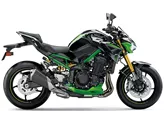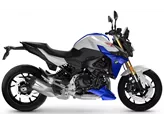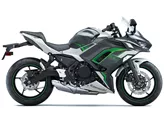Kawasaki Z900 2017 vs. Kawasaki Z1000 2013

Kawasaki Z900 2017

Kawasaki Z1000 2013
Vue d’ensemble - Kawasaki Z900 2017 vs Kawasaki Z1000 2013
The Kawasaki Z900 2017 and the Kawasaki Z1000 2013 are both naked bikes with similar engine types, in-line four-cylinder engines with liquid cooling. However, there are several key differences between the two models.
In terms of engine power, the Z1000 2013 has a slight advantage with 138 HP compared to the Z900 2017's 125.4 HP. The Z1000 also has a higher torque of 110 Nm compared to the Z900's 98.6 Nm. This means that the Z1000 may have slightly better acceleration and top speed compared to the Z900.
Both bikes have a double cradle frame, but the Z900 2017 has a steel frame while the Z1000 2013 has an aluminum frame. This could result in a difference in weight and handling characteristics. The Z900's steel frame may provide a more stable and comfortable ride, while the Z1000's aluminum frame could offer better agility and responsiveness.
In terms of suspension, both bikes have upside-down telescopic forks at the front. However, the Z900 2017 only has preload and rebound adjustment, while the Z1000 2013 has additional compression adjustment. This means that the Z1000 may offer more customizable suspension settings for different riding conditions.

Kawasaki Z900 2017
Both bikes have double disc brakes at the front with four-piston calipers. The Z900 2017 has petal technology, while the Z1000 2013 has radial petal technology. This could result in slightly different braking performance, with the Z1000 potentially offering better stopping power and heat dissipation.
In terms of tire dimensions, the Z900 2017 has a front tire width of 120 mm and a rear tire width of 180 mm. The Z1000 2013 has a slightly wider rear tire with a width of 190 mm. This could result in slightly different handling characteristics, with the Z1000 potentially offering better grip and stability in corners.
The wheelbase of the Z900 2017 is slightly longer at 1450 mm compared to the Z1000 2013's 1440 mm. This could result in slightly better stability and straight-line performance for the Z900.
In terms of seat height, the Z900 2017 has a lower seat height of 795 mm compared to the Z1000 2013's 815 mm. This could make the Z900 more accessible to shorter riders.

Kawasaki Z1000 2013
In terms of strengths, the Z900 2017 has an ingenious naked bike chassis, superb looks, and a responsive engine with well-balanced torque. It is also considered to offer a good balance between performance, price, and practicality.
The Z1000 2013, on the other hand, is praised for its powerful engine, rich sound, and unique design.
In terms of weaknesses, the Z900 2017 has a narrow knee angle that may be uncomfortable for taller riders. The Z1000 2013 lacks traction control and has been described as having a nervous chassis.
In conclusion, the Kawasaki Z900 2017 and the Kawasaki Z1000 2013 are both impressive naked bikes with their own strengths and weaknesses. The Z900 offers a well-rounded package with its chassis, looks, and engine performance, while the Z1000 boasts a powerful engine and unique design. Ultimately, the choice between the two models will depend on individual preferences and priorities.
Caractéristiques techniques Kawasaki Z900 2017 par rapport à Kawasaki Z1000 2013
Avantages et inconvénients en comparaison
Avantages et inconvénients en comparaison
Kawasaki Z900 2017

Une moto très réussie. Elle est le fruit de nombreux tests et d'un grand souci du détail. Elle a exactement la bonne puissance, exactement le bon châssis et exactement le bon look. Une nakedbike parfaitement réussie qui te rendra heureux pendant longtemps. Si tu veux, tu peux la conduire simplement et fidèlement, mais si tu le souhaites, elle peut aussi être ultra-rapide et vrombir méchamment. Superbe !
Kawasaki Z1000 2013

Dans l'ensemble, le nouveau Z1000 est donc une évolution réussie de son prédécesseur. L'absence de contrôle de traction est plus un problème de marketing qu'un problème pour les clients finaux.
Comparaison des prix Prix moyen du marché Kawasaki Z900 vs Kawasaki Z1000
There are a few key differences between a Kawasaki Z900 2017 and a Kawasaki Z1000 2013. In terms of price, the actual average price of a Kawasaki Z900 2017 is about 8% higher. A Kawasaki Z900 2017 experiences a loss of 520 USD in one year and 920 USD in two years of ownership. This is offset by a loss of 730 USD and 730 USD for a Kawasaki Z1000 2013. Compared to Kawasaki Z1000 2013 there are more Kawasaki Z900 2017 bikes available on the 1000PS.de Marketplace, specifically 43 compared to 4. It takes less time to sell a Kawasaki Z1000 with 69 days compared to 85 days for the Kawasaki Z900. Since model year 2017 1000PS.de editors have written 46 reviews for the Kawasaki Z900 and 41 reviews for the Kawasaki Z1000 since model year 2005. The first review for the Kawasaki Z900 was published on 11/11/2016 and now has more than 93,200 views. This compares to more than 5,800 views for the first review on Kawasaki Z1000 published on 9/2/2002.

















